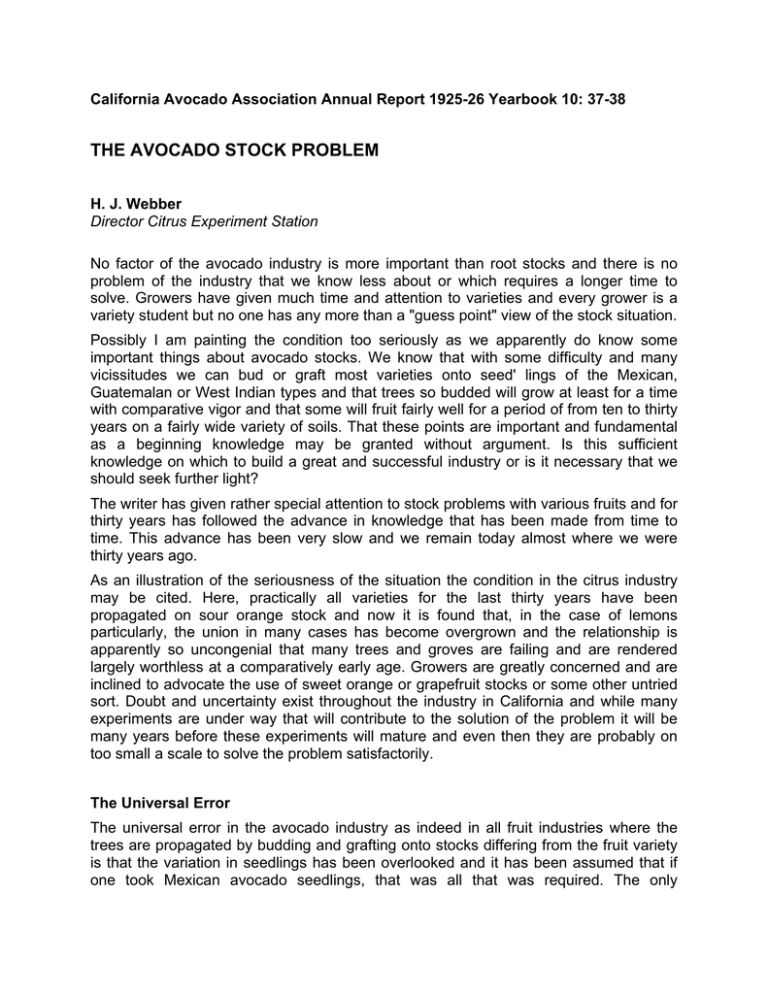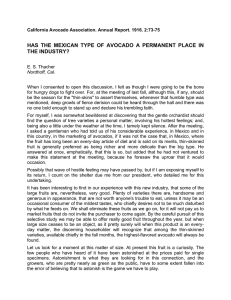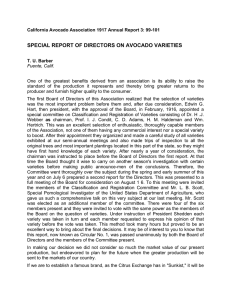THE AVOCADO STOCK PROBLEM
advertisement

California Avocado Association Annual Report 1925-26 Yearbook 10: 37-38 THE AVOCADO STOCK PROBLEM H. J. Webber Director Citrus Experiment Station No factor of the avocado industry is more important than root stocks and there is no problem of the industry that we know less about or which requires a longer time to solve. Growers have given much time and attention to varieties and every grower is a variety student but no one has any more than a "guess point" view of the stock situation. Possibly I am painting the condition too seriously as we apparently do know some important things about avocado stocks. We know that with some difficulty and many vicissitudes we can bud or graft most varieties onto seed' lings of the Mexican, Guatemalan or West Indian types and that trees so budded will grow at least for a time with comparative vigor and that some will fruit fairly well for a period of from ten to thirty years on a fairly wide variety of soils. That these points are important and fundamental as a beginning knowledge may be granted without argument. Is this sufficient knowledge on which to build a great and successful industry or is it necessary that we should seek further light? The writer has given rather special attention to stock problems with various fruits and for thirty years has followed the advance in knowledge that has been made from time to time. This advance has been very slow and we remain today almost where we were thirty years ago. As an illustration of the seriousness of the situation the condition in the citrus industry may be cited. Here, practically all varieties for the last thirty years have been propagated on sour orange stock and now it is found that, in the case of lemons particularly, the union in many cases has become overgrown and the relationship is apparently so uncongenial that many trees and groves are failing and are rendered largely worthless at a comparatively early age. Growers are greatly concerned and are inclined to advocate the use of sweet orange or grapefruit stocks or some other untried sort. Doubt and uncertainty exist throughout the industry in California and while many experiments are under way that will contribute to the solution of the problem it will be many years before these experiments will mature and even then they are probably on too small a scale to solve the problem satisfactorily. The Universal Error The universal error in the avocado industry as indeed in all fruit industries where the trees are propagated by budding and grafting onto stocks differing from the fruit variety is that the variation in seedlings has been overlooked and it has been assumed that if one took Mexican avocado seedlings, that was all that was required. The only information retained by nurserymen and passed on to the grower was that the trees were budded on Mexican stocks. We, however, are all familiar with the fact that there are many and widely varying types of Mexican avocados and that to merely use Mexican seedlings is very indefinite. A batch of seedlings grown from seeds taken from one tree may be quite variable one from another but if batches of seeds are taken from widely different trees the resulting seedlings are certain to vary much more widely. The latter policy is the one that is now being followed quite generally. The seeds from all types and of all varieties of Mexican avocados are jumbled together and grown as budding stocks and the trees grown on them sold as on Mexican stock. It will be clear to all growers, I think, on reflection that this is a crude and unsatisfactory method. We need to use seeds from a tree that is known to produce seedlings of uniform type, that are vigorous, but easily, give good, long lived, productive trees and react favorably with the fruit variety we desire to grow. In other words, we must use seeds only from selected stock trees. The evidence that has been obtained in various fruit industries such as citrus, apples, pears, etc., indicates very clearly that different fruit varieties react differently on different individual seedling stocks that are really very closely related and appear in most characters to be nearly identical. Different stock seedlings may change the fruiting tendencies and even the general quality of the fruit and give different reactions on different sorts and with different fruit varieties. It thus seems evident that in the future, stock varieties must be chosen because of their known effects on certain fruit varieties and on certain soils. Fuerte may require a different stock from Dickinson and the best Fuerte stock on light soils may not be satisfactory on a heavy soil. The problem is thus one of great complexity and we have no safe scientific method of estimating what reaction will result from a certain combination but must determine this by actual field trials -which to be conclusive must be extensive. The Great Problem The problem before us is to locate the one seedling among thousands, be it Mexican, Guatemalan or West Indian, the progeny of which will give us the best results with a certain fruit variety on a certain soil. This is a problem of such magnitude that only by a united effort can it be attacked with any great hope of solution within reasonable time. To reach a final solution every grove planted must, in a sense, be an experiment and be so definite as to stock and bud as to furnish exact data that may ultimately be used in solving the problem. The writer therefore desires to urge most strongly that hereafter or as soon as possible no avocado trees be purchased and planted that are not produced on named stock varieties. The following plan of operation is proposed: Naming Stock Varieties We have now no stock varieties and each grower or nurseryman producing trees will have to select and name his own stock varieties. He can do this just as easily as he can select a fruit variety. It should be remembered that a fruit variety is nothing more than a seedling that is chosen because it produces what the selector thinks to be an exceptionally good and valuable fruit. It is given a name and propagated and a new variety has come into existence. This selection is based on individual judgment only and the experience of commercial cultivation may later demonstrate that the variety is inferior to other sorts and ultimately perhaps it is discarded. In every fruit industry probably 95 per cent, of the varieties named are relegated finally to the "dump heap" yet they have served their purpose. No man is so careful or so omnipotent in judgment that he can be certain that his new variety is going to succeed as a commercial sort and supplant those already grown. The value of a new sort becomes known only through extensive experience and so it is only by naming and introducing into cultivation such promising seedlings when they are discovered that we finally locate the supremely valuable sorts on which our commercial fruit industries are founded. It is the writer's judgment that only in this way and by this method can we finally locate the best stock varieties on which the great avocado industry of the future can be safely builded. Selecting Stock Varieties The seeds that are now used in California to grow stock seedlings are, I believe, all produced in California and are taken mainly from seedling trees of the Mexican type that are grown here and there over the state. Usually the fruits are sold to hotels and restaurants and the seeds are bought by nurserymen from these hostelries and are of course mixed lots. The writer would propose that this policy be abandoned at the earliest possible date and that nurserymen select certain good old seedlings that from careful examination they believe to be promising as stock varieties and that then they name these and use seeds only from these named sorts for propagating. Suppose that a nurseryman has a dozen different seedlings from which he can obtain seed; it is not likely that all of these are equally good. He would plant the seeds from each tree separately and grow them separate in the nursery. Observing these batches of seedlings during their growth he would be able to determine which of the dozen produced the most uniform batch of seedlings and which gave the best growth, took the buds the best and gave the most satisfactory batch of budded nursery trees. This best seedling of the original dozen should then be named as a stock variety and sufficient trees propagated from it to furnish the number of seeds every year that he desires to grow for nursery purposes. If his name is Smith he might call it the Smith avocado but he should choose a name that has not before been applied to any other avocado variety. There is no end of names and he might call it the Volt, the Ooom, the Eureka or the Excelsior. Any name is good that is short and easily pronounced. If he calls it the Smith, then he would later offer Fuertes, Pueblas, Dickinsons, etc., budded on Smith stocks. In naming the Smith variety he should in his circulars and in the Proceedings of the Avocado Association describe exactly where the original tree is located and its general character and why he has chosen it as a stock variety. After the Smith variety has been named other nurserymen or growers desiring to grow trees on this stock, would have to get their seeds from Mr. Smith, or they could buy from him a few budded trees of the Smith from which they could grow their own supply of Smith seedlings to bud. In growing and testing batches of seed from the dozen or more different seedlings it may be that 2 or 3 batches of seedlings from different trees seem equally good and equally uniform. In this case give each one a different name and consider it a different variety so its record and history as a distinct type may be kept separate. If all the nurserymen growing avocado trees found that there was a demand for avocado trees on known stock varieties we would soon have many named stock varieties. As a matter of fact seeds could and should be tested from many of the varieties of the Mexican type that have already been named such, for instance, as the Chappelow, Carton, Northrop, Asusa, Harman, Ganter and the like and some one of these already named varieties might prove to be superior as a stock type. What is most important is that the record be kept accurately so that a grower will know that his Fuertes are on a certain stock, as Chappelow, for example. How Would This Help? Different nurserymen would naturally use different seedlings and make their own selections of stock types, and soon Fuerte would be offered by different nurserymen on very many different stock varieties of the Mexican type and these would be sold to different growers in different parts of the state and would be planted on many different soil types. Soon growers would be able to compare results obtained just as they now compare varieties and it would gradually come to be known that a certain variety on a certain stock was most fruitful. At any time after Fuerte had been propagated on a considerable number of stock varieties and had been fruiting for a sufficiently long period a careful survey by an investigator or a committee would almost certainly indicate pretty clearly what stock variety had given the best results, and it might easily be possible that a stock variety most successful on a sandy soil would not prove to be the best on a heavy adobe soil. By using named stock varieties we would lose nothing over our present method but would probably from the first be better off than now, as we would be using seeds from good selected trees in all cases rather than a mixed lot and we would furthermore be putting ourselves in a position so that in the near future a really superior variety could be chosen with a degree of safety that could never be obtained by small plot experiments. Difficulties in Plan The principal difficulty in getting the plan underway is that the nurserymen must take the fruits from certain trees and keep them separate under name. A nurseryman could not sell the fruits to restaurants and have the seeds returned to him unless under very special arrangement where the restaurant would use only the one variety of fruit. If mixed lots of fruits were used the seeds would get mixed. To be sure of the results a nurseryman would have to grow the trees from which he is to take seeds and sacrifice the fruit for the seed. I cannot conceive this, however, to be a serious objection to the plan, as such fruits can certainly be grown at a good profit at 10 cents apiece and who would consider an additional 10 cents per nursery tree as important for a tree on known good stock when he pays in any case from $2.00 to $5.00 per tree. Another objection that may be raised is that the grower cannot recognize the type of stock on which his trees are budded and that there would be additional opportunity for fraud. This is doubtless true but after all most men are honest and there would be little to be gained here from a fraudulent practice even if not easily detected. The dishonest and unreliable nurseryman soon comes to be known and the establishment of a reputation for care and honesty is too great an asset in such a business as to be lightly thrown away. I think, therefore, that this difficulty is not a serious objection to the plan. It may also be objected that even when we take seeds from a named stock variety we are still using seedlings and will have variable stocks. This is, indeed, true and as long as we use seedlings for stocks we will have some variability. However, it is well known that seeds from certain trees will produce much more uniform lots of seedlings than seeds from certain other trees and it is one of the important factors in the selection of such stock varieties to get a variety that will produce as uniform lots of seedlings as possible. Certain it is, furthermore, that we can get greater uniformity by using seeds from one selected type than from all sorts of mixed types. Planting groups of trees of the stock variety in isolated places that will insure a considerable degree of self fertilization may also increase the uniformity of the seedlings without injuring their vigor, but this is not definitely known. It seems to the writer that we can be sure that seedlings from certain varieties will give better results than seedlings from certain other varieties and thus that the fundamental part of the plan rests on a safe and sane basis. It is true that we may ultimately propagate many' of our varieties by cuttings, and thus on their own roots, but this is not yet known to be feasible and we will probably always have reason to use a good many seedlings in propagation that should come from a good and well known stock variety. What has been said above has referred mainly to the selecting of stock varieties of the Mexican type and it may be objected that we do not yet know that the Mexican is any better than the Guatemalan. It is probably true that the evidence available in favor of the Mexican type is not entirely conclusive yet it does seem to be sufficiently extensive to justify the conclusion that the Mexican in general is a satisfactory stock and if this is true then a specially selected superior Mexican type should be much more satisfactory than the mixed Mexican we are now using. Stock varieties should also be selected and tested of the Guatemalan and other types but these should at first be grown in experimental quantities only, as the evidence at present is strongly favorable in general to the superiority of the Mexican type as a stock. The extension of this plan in the industry must necessarily be slow but it seems to hold out sufficient promise to justify its gradual adoption. Progressive nurserymen, I believe, will see in it an opportunity for achievement and be willing to work toward the end desired. We cannot in a year or two years get prepared to offer only trees on named stocks but if we work and push toward this end it will be only a few years before such trees are very generally offered. Is not the end result worth the effort?




